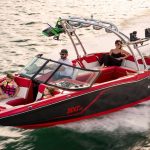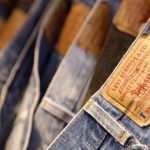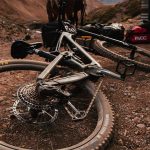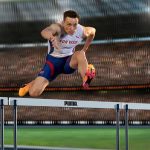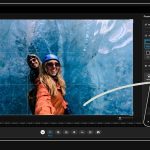Overall sales for the entire winter sport market (including specialty and chain stores), were up 4% in dollars to $2.3 billion for the August 2005 through March 2006 period,
compared to $2.2 billion reported last year, according to the SIA Retail Audit. Unit sales were up 6%.
Sales at specialty ski and snowboard shops were up 4% in dollars compared to last season. In dollars,
that translates to $1.8 billion in sales this season as compared to $1.7 billion for last season. Unit sales
were up from last season 4%. “Products that touted technology, snowsport as a lifestyle, warmth and
comfort drove sales this season. Integrated systems took over the alpine ski category, freestyle twintip
skis were the fastest growing equipment category and accessories generated more dollars than
equipment this season,” said Christine Martinez, market research manager for SIA, the not-for-profit
industry trade group that represents manufacturers and distributors of snow sports products. The SIA
Retail Audit tracks and reports sales in all snow sports product categories. This is the final report of six
that looks at sales through March 31, 2006, the end of the winter season.
PRELIMINARY INTERNET SALES REACH $260M
While the projection model has yet to be formally calculated, preliminary findings from tracking sales
through the Internet distribution channel tell us that approximately $260 million in snowsports products
were sold online this season. That is 14% of all specialty store sales. Same store sales point to a
remarkable 13% dollar increase this season over last. Warm weather in the East put a damper on total
rental and shop service incomes. This season, approximately $57 million was generated by downhill
equipment rentals, a 15% decline from the previous season. Shop services fell 21% to $35 million this
season.
INSULATED PARKAS 80% SOLD-THROUGH BY END OF SEASON
Specialty apparel sales (including tops, bottoms, suits and snowboard) had a very successful season, up
7% in dollars as compared to last season. By the end of March 2006, apparel sales totaled $582.7
million.
Insulated parkas, 42% of all alpine apparel top dollars sold, rose 8% in dollars this season over last with
sales reaching $149.0 million by the end of March. Womens and junior insulated parkas, specifically,
showed considerable dollar gains, each sub-category up 12% and 9%, respectively, over last period.
Womens continue to lead the category with $72.2 million in sales. This season, womens units outsold
mens 1.5 to 1. Juniors accounted for a noteworthy 17% of all insulated parka dollars sold this season.
At the end of March, all insulated parkas were 80% sold-through, 1 percentage point behind last season.
Softshell parka sales prospered in specialty and chain stores this season. Dollar sales jumped 36%
when comparing this season to last, reaching $23.6 million in sales by the end of March.
As with insulated parkas, the softshell parka category attributed their increase to womens and junior
parkas. Womens and juniors demonstrated impressive dollar increases, 75% and 637%, respectively.
Womens softshell sales accounted for 36% of all softshell dollars sold, up from 28% last season. At the
end of March, softshells were 77% sold-through, up from 72% a year ago.
Shell parkas continue to hold their own with a moderate 15% dollar gain over last season. Sales grew to
$60.2 million by the end of March. Junior shell parkas grew in popularity this season, up 38% in dollar
sales over last season. Even with the dramatic sales increase, juniors only accounted for 4% of all shell
dollars sold.
Vests (no fleece) and fleece (includes vests) continued to generate the increase in sales which began
last season. Dollar sales were up for both categories, 31% and 14%, respectively, over last season.
Vests were 82% sold-through at the end of March.
This season, carryover top sales accounted for 6% of all alpine apparel top dollars sold, down from 10%
last season. All carryover top sales fell 31% in dollars.
Apparel bottoms increased 2% in dollars over last year with junior bottoms contributing an impressive
dollar gain of 22%. Insulated waist pants, accounting for 34% of all alpine bottom dollars (up from 28%
last season), leapt 24% in dollars. Shell pants accounted for 22% of all alpine bottom dollars sold this
season and increased 6% in dollars over last season. This season, junior alpine bottoms dollars
accounted for 14% of all bottom dollars sold, up from 12% last season. Junior alpine bottoms increased
22% in dollars this season over last.
Apparel suits did not fare so well this season, dipping 33% in dollars. Junior suits, on the other hand,
performed better, up 7% in dollars as compared to last season.
Snowboard apparel sales grew 15% in dollars totaling $97.0 million in sales by the end of March.
Snowboard tops and snowboard bottoms performed well over last season, up 22% and 19%,
respectively. Mens snowboard tops and bottoms led the category all season with $24.8 million and
$20.0 million, respectively, in sales.
With mens tops outselling womens 1.9 to 1 this season, there is still plenty of room for womens top
sales to grow. At the end of the season, mens snowboard tops were 73% sold-through, womens sellthrough
stood at 70% and juniors were just 41% sold-through. Junior snowboard top sales fell 4% in
dollars and accounted for just 7% of all snowboard top dollars sold this season, down from 9% last
season.
In dollars, mens snowboard bottoms increased 20%, womens grew 27% and juniors fell 9%. At the end
of March, all snowboard bottoms were 79% sold-through.
SPECIALTY RETAILERS SELL $600M IN ACCESSORIES THIS SEASON
In the August to March selling season, specialty retailers sold a total of $600.1 million in both equipment
and apparel accessories, ending the season up 7% in dollars over last season. The apparel accessories
category increased sales 4% over last year, totaling $329.9 million by the end of this season. Winter
boots (up 12%), gloves (up 18%), mitts (up 14%), base layer (up 3%) and neck gaiters (up 16%)
contributed to this dollar increase.
Equipment accessories increased 10% with dollar gains from goggles (up 9%), sunglasses (up 18%),
snowshoes (up 14%), helmets (up 16%), technical day packs (up 35%), luggage (up 12%), wax (up 5%)
and snowboard accessories (up 13%).
SNOWBOARD SALES END SEASON 69% SOLD-THROUGH
From August through March 2006, snowboard equipment sales (including snowboards, boots and
bindings) were up 3% in dollars with sales totaling $206.2 million. Snowboards (up 2% to $93.7 million),
boots (up 4% to $60.3 million) and bindings (up 4% to $52.3 million) all experienced dollar increases this
season over last.
At the end of March, specialty retailers were 69% sold-through and had 17% fewer snowboards in stock
than they did at the end of March 2005. Freestyle boards, 47% of all snowboard dollars sold this season
(up from 40% last season), performed well with a dollar increase of 21%. Adult freestyle boards were
70% sold-through at the end of March.
Freeride boards, 39% of all board dollars sold, saw dollar sales increase 2% and sales totaling $38.3
million by the end of March. All mountain boards, 10% of all snowboard units sold this season, declined
15% in dollar sales with $7.3 million in sales by the end of March 2006. Carryover unit sales plunged
62% reaching $3.2 million in sales by the end of March. Carryover boards accounted for just 5% of all
boards sold this season, down from 13% last season.
At seasons end, adult snowboard boots were 67% sold-through, up from 64% last season. Adult
snowboard bindings were 74% sold-through at the end of March, up from 66% sold-through a year ago
at this time. Step-in boots and bindings continued their decline this season, with 65% and 60% declines,
respectively, in dollar sales over last season.
FREESTYLE TWINTIP SKIS ARE FASTEST GROWING EQUIPMENT CATEGORY THIS SEASON
Overall equipment sales (alpine, snowboard, Nordic, Telemark and Randonee/AT) ended the season
down 1% in dollars over last season with sales totaling $616.0 million from August through March 2006.
In specialty stores, alpine ski equipment (including skis, ski systems, boots, bindings and poles) fell a
slight 2% in dollars this season over last.
Integrated system sales continued to escalate this season totaling $97.1 million through the end of
March, an increase of 19% in dollars when comparing this season to last. At the end of March, 77,000
integrated systems remained in specialty retail inventory. By end-March the category was 72% soldthrough,
down slightly from the 74% sell-through figure at the end of the 2004/05 season.
Add integrated systems to alpine skis and total unit sales slid 4%. Alpine skis, excluding integrated
systems, fell 16% in dollars over last season, ending the season with $85.3 million in sales. End-March
inventory stood at 131,000 units, 47,000 fewer units than at the end of March 2005 — a 26% decline. At
the end of this season, all bindingless skis were 69% sold-through, two points ahead of last season.
This season, the ratio of adult flat skis to adult integrated systems fell to 1.1 to 1; compare that to the 1.7
to 1 ratio for the 2004/05 season. Of the 203,000 integrated systems sold this season, 49% were carve
skis and 42% were midfats.
Twintip ski sales were impressive this season, up 59% in dollars and reaching $8.7 million in sales by the
end of this season. At end of season, 13,000 pairs remained on-hand and the category was 66% soldthrough,
up from 61% a year ago. These figures do not include twintip skis designed for all mountain
use. Those are tracked within the midfat, fat and carve categories. Fat alpine skis continue to sell with
an increase of 45% in dollars over last season. Though still a tiny category with just 3,500 units sold this
season, super fat skis leapt 144% in dollars.
Carve skis, 24% of all flat ski dollars sold (down from 30% last season), are down 32% in dollar sales.
Midfat alpine skis, 28% of all alpine ski dollars sold this season, down from 32% of all dollars last season,
fell 26% in dollars when compared to the same August through March period last season.
All ski carryover sales decreased a healthy 42% in dollars. End-season carryover ski inventory stood at
just 13,000 units, 68% fewer units than at the same time last year.
Junior systems, 7% of all system units sold (up from 3% last season) jumped 143% in dollars. Junior
skis, excluding systems, are up 15% in dollars over last season. End-season inventories stood at 37,000
units, down from 42,000 units at the end of March 2005. Added together, both junior integrated systems
and junior skis were 71% sold-through at the end of this season.
From August through March 2006, total alpine boot sales had increased 1% in dollars ($150.9 million in
sales). By end-March, 600,000 pairs of alpine boots were sold — 100,000 more units than all integrated
systems and alpine skis combined.
Adult sport performance boots, 33% of all boot dollars sold this season, increased 11% in dollars. High
performance boots, 44% of all boot dollars sold, increased just 2% in dollars. Adult recreation boot sales
accounted for 10% of all boot dollars sold, up from 8% last season, and saw a dollar increase of 18%.
Carryover boot sales fell 27% in dollars and this season accounted for 6% of all boot units sold, down
from 10% for the 2004/05 season. Junior boot dollars increased 3% over last season. Through March,
total units sold stood at 113,000 — nearly 6,000 more units than the combined number of junior skis and
junior integrated systems sold.
The growth of integrated systems has clearly resulted in a decline in sales of stand-alone bindings.
Stand-alone binding sales fell 22% in dollars, totaling $27.9 million at the end of March. At the end of
this season, bindings were 64% sold-through, the same as last season. Add stand-alone bindings to
those attached to integrated systems and total binding sales gained 7% in dollars.
DIN 8-11 bindings, 39% of all binding units sold this season (down from 46% last season) fell 33% in
dollars. Higher-end performance DIN 12-14 bindings (36% of all binding dollars sold this season)
declined only 8%. Similar to junior ski sales, junior alpine binding sales grew 5% in dollars. Through
March, junior binding sales totaled 88,000 units, only 6,000 units fewer than the number of junior skis
sold in the same period.
The alpine pole category is up 11% in dollars over last season in part due to a 19% increase in adult
poles (80% of all units sold this season).
NEW YEARS WARM WEATHER PUNISHES NORDIC CATEGORY
The Nordic ski equipment category is showing a decrease of 17% in dollars this season over last. Nordic
skis (down 19% to $11.9 million), boots (down 19% to $10. million) and bindings (down 18% to $4.1
million) all experienced dollar declines. However, Nordic poles managed a 3% hike as compared to the
same period last season. At the end of March, Nordic boots were only 55% sold-through. Sell-through
for Nordic skis was 63% and bindings 68%.
Last seasons early snow in the West may have played a factor in the sales (dollars down 20%) of
Telemark ski equipment. Sales of Telemark skis, boots and bindings dropped in dollars 10%, 23% and
26%, respectively.

